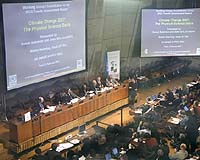| . |  |
. |
Honolulu HI (SPX) Nov 23, 2010 Current state-of-the-art global climate models predict substantial warming in response to increases in greenhouse gases such as carbon dioxide. The models, though, disagree widely in the magnitude of the warming we can expect. The disagreement among models is mainly due to the different representation of clouds. Some models predict that global mean cloud cover will increase in a warmer climate and the increased reflection of solar radiation will limit the predicted global warming. Other models predict reduced cloudiness and magnified warming. In a paper that has just appeared in the Journal of Climate, researchers from the University of Hawaii Manoa (UHM) have assessed the performance of current global models in simulating clouds and have presented a new approach to determining the expected cloud feedbacks in a warmer climate. Lead author Axel Lauer at the International Pacific Research Center (IPRC) at UHM notes, "All the global climate models we analyzed have serious deficiencies in simulating the properties of clouds in present-day climate. It is unfortunate that the global models' greatest weakness may be in the one aspect that is most critical for predicting the magnitude of global warming." To study the clouds, the researchers applied a model representing only a limited region of the atmosphere over the eastern Pacific Ocean and adjacent land areas. The clouds in this region are known to greatly influence present climate, yet current global models do poorly in representing them. The regional model, developed at the IPRC, successfully simulates key features of the region's present-day cloud fields, including the observed response of clouds to El Nino. Having evaluated the model's simulation of present-day conditions, the researchers examined the response of simulated clouds in a warmer climate such as it might be in 100 years from now. The tendency for clouds to thin and cloud cover to reduce was more pronounced in this model than in any of the current global models. Co-author Kevin Hamilton concludes, "If our model results prove to be representative of the real global climate, then climate is actually more sensitive to perturbations by greenhouse gases than current global models predict, and even the highest warming predictions would underestimate the real change we could see." This research was supported by the Japan Agency for Marine-Earth Science and Technology (JAMSTEC), by NASA through Grant NNX07AG53G, and by NOAA through Grant NA09OAR4320075, which sponsor research at the International Pacific Research Center. This research was also supported by NOAA/CPPA Grant NA07OAR4310257 and DOE Regional and Global Climate Modeling (RCGM) Program Grant ER64840. Lauer, A., K. Hamilton, Y. Wang, V. T. Phillips, and R. Bennartz (2010), The Impact of Global Warming on Marine Boundary Layer Clouds over the Eastern Pacific - A Regional Model Study, Journal of Climate, Vol. 23, No. 21, 5844?.
Share This Article With Planet Earth
Related Links University of Hawaii at Manoa Climate Science News - Modeling, Mitigation Adaptation
 Next climate warming report will be dramatically worse: UN
Next climate warming report will be dramatically worse: UNUnited Nations (AFP) Nov 22, 2010 United Nations leaders will demand "concrete results" from the looming Cancun climate summit as global warming is accelerating, a top UN organizer of the event said Monday. Robert Orr, UN under secretary general for planning, said the next Intergovernmental Panel on Climate Change report on global warming will be much worse than the last one. Representatives from 194 countries are to mee ... read more |
|
| The content herein, unless otherwise known to be public domain, are Copyright 1995-2010 - SpaceDaily. AFP and UPI Wire Stories are copyright Agence France-Presse and United Press International. ESA Portal Reports are copyright European Space Agency. All NASA sourced material is public domain. Additional copyrights may apply in whole or part to other bona fide parties. Advertising does not imply endorsement,agreement or approval of any opinions, statements or information provided by SpaceDaily on any Web page published or hosted by SpaceDaily. Privacy Statement |